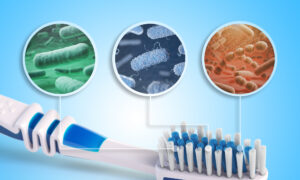How Dirty Is Your Toothbrush?

Toothbrushes may harbor illness-causing bacteria, but the way you store and care for your brush may influence its bacterial load significantly.
- Your toothbrush serves as a reservoir for microorganisms and becomes contaminated with infectious organisms soon after its initial use.
- In both healthy people and those with oral disease, pathogenic bacteria and viruses were detected on toothbrushes, including E. coli and herpes simplex virus.
- One study found heavy contamination with pathogenic microorganisms in 70 percent of toothbrushes after use.
- Storing toothbrushes in communal bathrooms isn’t recommended—at least 60 percent were contaminated with fecal coliforms, no matter how they were stored or cleaned.
- The best way to store your toothbrush is in a dry environment where it can air-dry—placing your toothbrush into a closed container isn’t a good idea, as this may keep your toothbrush moist, allowing bacteria to flourish.
- Dipping your toothbrush into 3 percent hydrogen peroxide may reduce bacterial load by 85 percent.
Dutifully brushing your teeth twice a day is an essential part of good hygiene, but what if the toothbrush itself isn’t clean? The fact is your toothbrush is far from sterile and by the very nature of brushing your teeth becomes contaminated with bacteria, saliva, blood, debris from your mouth, and more after every brushing.[1]
Depending on where your toothbrush is stored, such as in the bathroom, it’s also possible that debris from the toilet may find its way onto the bristles—and subsequently into your mouth.[2] In the United States, health organizations including the CDC [Centers for Disease Control and Prevention] acknowledge that “even after being rinsed visibly clean, toothbrushes can remain contaminated with potentially pathogenic organisms.”[3]
That being said, unless you have a serious condition such as certain bleeding disorders or immunosuppression, which may necessitate cleaning your teeth with a method other than a less-than-hygienic toothbrush, adverse health effects due to regular toothbrush use are unlikely.[4]
Your toothbrush serves as a reservoir for microorganisms and becomes contaminated with infectious organisms soon after its initial use—and the contamination grows with each use thereafter, according to a systematic review of toothbrush contamination published in the journal Nursing Research and Practice.[5]
“Toothbrushes can become contaminated from the oral cavity, environment, hands, aerosol contamination, and storage containers. Bacteria which attach to, accumulate, and survive on toothbrushes may be transmitted to the individual causing disease,” the researchers explained.[6]
For purposes of the review, they were particularly interested in toothbrushes used among vulnerable populations, including people in hospitals. Seven experimental and three descriptive studies were analyzed in all, revealing that toothbrushes retain a significant number of bacteria after use. In both healthy people and those with oral disease, pathogenic bacteria and viruses were detected on toothbrushes, including:[7]
- Staphylococcus aureus.
- E. coli.
- Pseudomonas.
- Herpes simplex virus, in numbers large enough to cause infection.
Among people with oral disease, toothbrushes may quickly become contaminated, though some toothbrushes were contaminated before they were even used. One study found heavy contamination with pathogenic microorganisms in 70 percent of toothbrushes after use, and many different types of bacteria were detected on toothbrushes in another study, with varying amounts of growth.
The best way to store your toothbrush is in a dry environment where it can air-dry. Placing your toothbrush into a closed container isn’t a good idea, as this may keep your toothbrush moist, allowing bacteria to flourish. Toothbrushes stored in closed containers, or those that came in contact with contaminated surfaces, contain higher levels of bacteria than toothbrushes allowed to dry in the open air.[8]
Storing your toothbrush in a humid environment is also likely to increase the survival of bacteria on your brush, as is placing a cap on it. Bacteria survived more than 24 hours on toothbrushes when moisture was present, while storing your toothbrush in a moist, covered environment may increase bacterial growth by 70 percent.[9]
The shape and design of your toothbrush may also affect its ability to retain germs. Specifically, if your bristles are frayed or arranged in a very close-together pattern, it’s possible that they’ll trap and retain more bacteria.
One study suggested that “soft and round, clear, two bristle row toothbrushes” were best in terms of contamination levels, while moisture and oral debris left in the bristles allow bacteria to flourish.[10] While it’s clear that toothbrushes are easily contaminated, its effects on human health are still being uncovered. According to the study:[11]
“The selected studies all found that toothbrushes of healthy and oral diseased adults become contaminated with potentially pathogenic bacteria from the dental plaque, design, environment, or a combination of factors … In a vulnerable population such as critically ill adults, pathogenic contamination may increase the risk of infection and mortality.”
Another factor in your toothbrush’s cleanliness is the common habit of storing them in bathrooms, where toilets are routinely flushed. “An association between inhalable bioaerosols produced from disturbed sewage and the transmission of infectious disease has been proposed for over 100 years,” wrote researchers in the American Journal of Infection Control.[12]
In other words, when a toilet is flushed, toilet plume aerosols are released into the air, and it’s possible that this could spread infectious disease, in part by the airborne microorganisms landing on your toothbrush. This mode of disease transmission dates back more than a century when researchers detected airborne transmission of microorganisms from sewage drain systems from one hospital building to another.[13]
In the 1950s, another study involved seeding toilets with Serratia marcescens bacteria, then flushing them to see where the bacteria ended up. Bacterial colonies were found to settle on the floor and microbes were also captured in the air—up to eight minutes after the flush. Even in toilets using “wash-down” flushing, in which the water is released from the toilet rim and flows down the bowl, bioaerosol was found above the toilet up to seven minutes after the flush.[14]
More recent research revealed that Clostridium difficile was detected above toilet seats up to 90 minutes after flushing. Flushing with the lid down made a positive difference, as bacteria concentrations were 12 times higher when the toilet was flushed with the lid up, compared to with the lid down.[15] Overall, the researchers noted:[16]
“It may be concluded … that flush toilets produce substantial quantities of toilet plume aerosol capable of entraining microorganisms at least as large as bacteria, that sufficiently small microbe-laden droplets will evaporate to form droplet nuclei bioaerosols small enough to be inhaled deep into the lung, and that these bioaerosols may remain viable in the air for extended periods and travel with air currents.
“Production of these bioaerosols during multiple flushes after contamination suggests a long-term potential for a contaminated toilet to be an infectious bioaerosol generator.”
A study presented at the 2015 annual meeting of the American Society of Microbiology looked directly into what happens to toothbrushes stored in communal bathroom settings, such as those in university housing. The researchers, from Quinnipiac University in Connecticut, collected toothbrushes from communal bathrooms that were used by an average of 9.4 people per bathroom and tested them for potentially pathogenic organisms.[17]
At least 60 percent were contaminated with fecal coliforms, no matter how they were stored or cleaned—no difference was found in toothbrushes rinsed with cold water, hot water, or mouthwash. It was estimated that, in 80 percent of cases, fecal coliforms on the toothbrushes came from another person using the bathroom.
“The main concern is not with the presence of your own fecal matter on your toothbrush, but rather when a toothbrush is contaminated with fecal matter from someone else, which contains bacteria, viruses or parasites that are not part of your normal flora,” study author Lauren Aber said in a news release.[18]
She noted that using a cover for toothbrushes won’t protect them from contamination either and, in fact, may increase bacterial growth because the bristles are kept moist and don’t dry out completely between uses.
There’s debate over the best way to clean a toothbrush, but the general consensus is that letting it air dry is essential. Some research has found that soaking toothbrushes in mouthwash for 20 minutes before and after brushing may lower its antimicrobial load, while exposure to ultraviolet light is also effective at reducing bacterial load on toothbrushes.[19]
However, the CDC states, “You do not need to soak toothbrushes in disinfecting solutions or mouthwash, which may actually spread germs under the right conditions.”[20] Rinsing your toothbrush with regular tap water isn’t likely to affect bacteria levels, as studies found “continued high levels of contamination and biofilm” on toothbrushes clean[ed] this way.[21]
One of the simplest ways to clean your toothbrush is to dip it into 3 percent hydrogen peroxide. This was the most effective option for reducing both aerobic and anaerobic bacteria on the toothbrush head, compared to mouthwash and water,[22] and may reduce bacterial load by 85 percent.[23]
Antimicrobial toothbrushes coated with triclosan did not alter bacterial growth on toothbrushes either and should be avoided due to triclosan’s toxicity. Be aware that if a toothbrush is labeled “antibacterial,” it may contain triclosan, an antibacterial chemical and known endocrine disrupter.
It’s so widely used that it’s estimated 75 percent of the U.S. population has been exposed, a concerning statistic since it is readily absorbed into human skin and oral mucosa, where it may affect immune responses, production of reactive oxygen species, and cardiovascular functions.[24] Reproductive and developmental effects have also been observed.
While it may sound unsettling that your toothbrush is a reservoir for microorganisms, it’s unlikely to pose a major health risk if you’re healthy. It’s recommended to get rid of your toothbrush after certain illnesses, like strep throat, to avoid reinfection, but in most cases, daily toothbrush use isn’t thought to be a source of illness.
According to the CDC, “Various means of cleaning, disinfecting, or sterilizing toothbrushes between uses have been developed, but no published research documents that brushing with a contaminated toothbrush has led to recontamination of a user’s mouth, oral infections, or other adverse health effects.”[25] There are, however, certain “best practices” you can use to care for your toothbrush, including:[26]
- Avoid sharing toothbrushes.
- Rinse your toothbrush after use to remove all toothpaste and debris.
- Store it in an upright position and let it air-dry.
- If storing in a holder with other toothbrushes, don’t let the toothbrushes touch each other.
- Do not put your toothbrush in the dishwasher or microwave, which may cause damage.
- Avoid covering toothbrushes or storing them in closed containers.
- Replace your toothbrush every three to four months or sooner if the bristles appear worn, matted, or frayed.
Originally published Sept. 23, 2022, on Mercola.com




